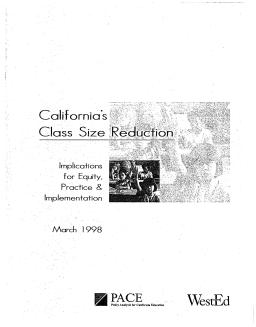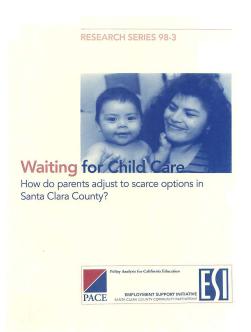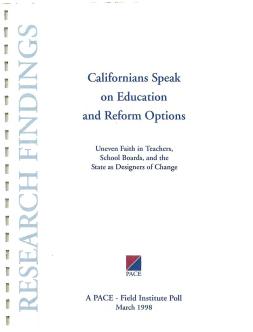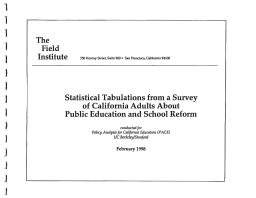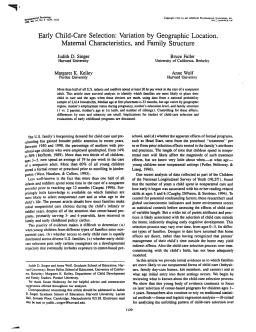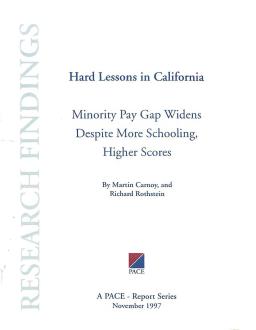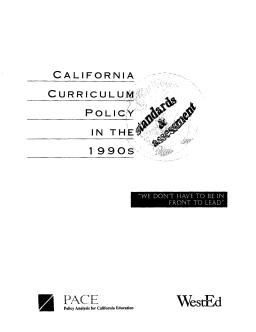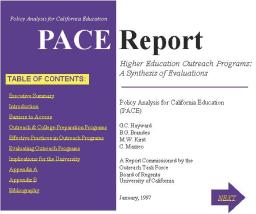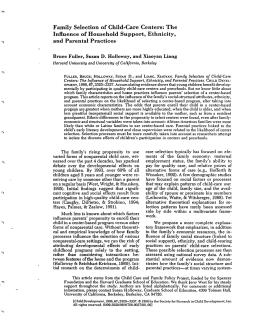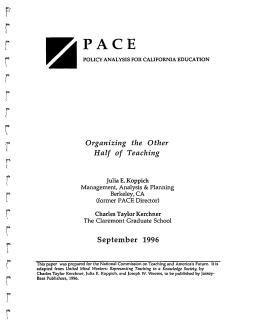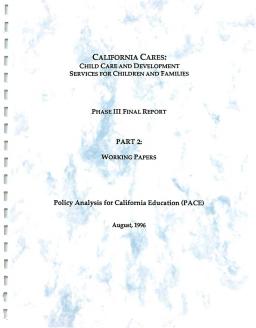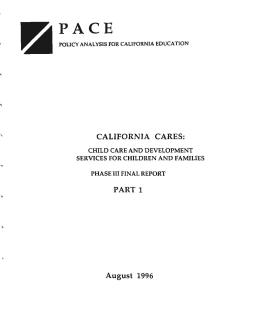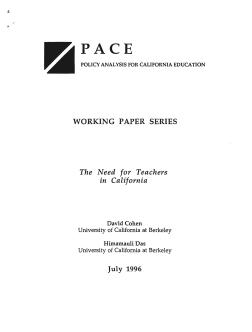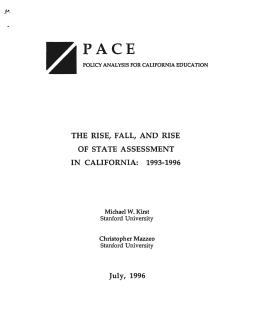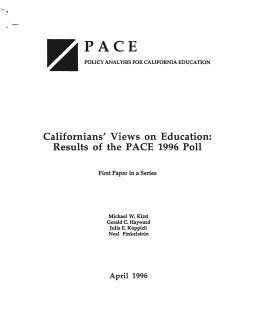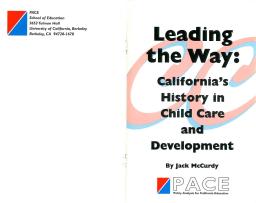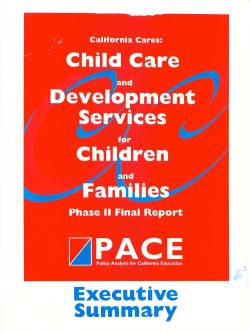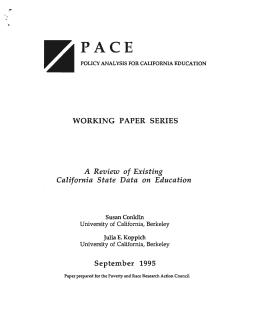Implications for Equity, Practice, and Implementation
Published
Summary
In 1996, CA launched a $1 billion class size reduction (CSR) initiative to improve early literacy. The initiative provides $800 per student to schools reducing class size to 20 or fewer in first, second, and/or third grade, and kindergarten. CSR was funded due to a state revenue surplus and the belief that smaller classes would enhance early literacy. CA ranked second to last in national reading tests in 1994, and class sizes averaged around 28.6 students per K-3 classroom. While educators and the public show enthusiasm, the success of CSR in enhancing academic achievement is yet to be seen.
How Do Parents Adjust to Scarce Options in Santa Clara County?
Published
Summary
In 1998, the PACE research center surveyed low-income and blue-collar parents to help streamline the process of finding childcare, in response to the state's welfare reform legislation. The survey included 300 in-depth interviews and covered topics such as employment, searching for childcare, interim childcare, and perceptions of care quality. The report addresses the policy problem and how parents perceive their limited childcare options.
Uneven Faith in Teachers, School Boards, and the State as Designers of Change
Published
Summary
Public education quality has long been debated, worrying parents, activists, and politicians. Recent polls show it is a top concern in California and the US. Politicians and activists propose school reform, and a new election season has begun. PACE and the Field Institute surveyed 1,003 Californians in February to assess their views on education quality, trusted reformers, and evaluating major proposals. The report details key findings.
Published
Summary
This volume presents the results of a PACE survey conducted by The Field Institute among 1,003 California adults via random digit dialing. Statistical weights were developed to match the sample of California adults interviewed to known parameters of the adult population. Estimates of sampling error from results based on the overall adult public sample are +/- 3 percentage points. Other possible sources of error include differences in question wording, sequencing, or undetected errors or omissions in sampling, interviewing, or data processing. The study professionals minimized such errors.
Variation by Geographic Location, Maternal Characteristics, and Family Structure
Published
Summary
This article uses survival analysis to examine factors associated with placing infants and toddlers in nonparental care, and at what ages. Using data from a national probability sample of 2,614 households, the study finds that the median age at first placement is 33 months and varies by geographic region, mother's employment status during pregnancy, education level, and family structure. Differences by race and ethnicity are small. The article discusses implications for studies of childcare selection and evaluations of early childhood programs.
California Families Face Gaps in Preschool and Child Care Availability
Published
Summary
This report highlights the unequal distribution of preschool and childcare opportunities in California. Despite spending $1.2 billion annually, half of preschool-age children live in households with working mothers, with enrollment dependent on income and location. Counties vary greatly in their supply, with affluent parents more likely to find preschool or childcare slots. Latino children are hit hardest, even in counties with ample supply, with supply in predominantly Latino areas half that of low-income Black or Anglo communities.
Minority Pay Gap Widens Despite More Schooling, Higher Scores
Published
Summary
African Americans and Latinos historically have lower educational attainment, achievement, and wages compared to whites. Narrowing education gaps between minorities and whites should narrow wage gaps. This report analyzes whether California's education gap improvement between minorities and whites led to a parallel reduction in wage gaps. The report finds that the educational attainment and achievement of California's minority youth improved significantly from the 1970s to 1988.
A Challenge for the New PACE
Published
Summary
Fall 1997 PACE Newsletter Volume 1 Number 1 This inaugural newsletter from Policy Analysis for California Education (PACE) covers a wide range of education policy issues affecting California’s K–12 system, including class size reduction, charter schools, standards-based reform, higher education outreach, and child care policy. Class size reduction is a major focus, with discussions on California’s $1.5 billion Class Size Reduction (CSR) initiative aimed at improving educational outcomes by limiting K–3 classes to 20 or fewer students. Enthusiasm among educators for smaller classes is high, but...
Standards and Assessments
Published
Summary
This study traces California's curriculum-related reforms in mathematics and science during the 1990s, examining the role of the California Department of Education and the state's shifting political and policy context. It analyzes the perceptions of state officials, experts, and the public and how they influenced state policy changes. The authors raise questions about problems associated with curriculum policy in California and presents policy recommendations mentioned during interviews and document analysis. The study does not assess the impact of curriculum on school practice.
A Synthesis of Evaluations
Published
Summary
The PACE report commissioned by the University of California aims to enhance university participation by disadvantaged and underrepresented students. It reviews evaluations of current outreach programs, identifies effective practices, and makes recommendations for program improvement and evaluation methods. The report analyzes the effectiveness of college preparation programs and suggests essential principles for program design. It also examines how to improve evaluations of outreach programs and the implications for policy decisions on future outreach efforts.
The Influence of Household Support, Ethnicity, and Parental Practices
Published
Summary
An investigation of the family factors and practices that influence parents' choice of center-based programs for young children. Maternal education, child's age, and availability of social support were found to be significant factors in center selection. African-American families were more likely to choose center-based care than white or Latino families, and parental practices related to early literacy development and close supervision also affected center selection. The study highlights the importance of considering selection processes when assessing the effects of early childhood programs.
1993–96
Published
Summary
This article discusses the California Learning Assessment System (CLAS), which aimed to align the state's testing system with the content of what was taught in schools and better measure student performance through performance-based standards and assessments. However, CLAS faced opposition from various groups and was ultimately discontinued. The case offers lessons for reformers about the politics of testing policy in the US and the difficulties of large-scale transformation of state assessment systems.
Published
Summary
The 1975 Rodda Act, also known as the Education Employment Relations Act, allowed California public school teachers to collectively bargain for employment terms. Similar laws exist in 37 states based on the National Labor Relations Act. This paper advocates for transforming education labor relations to position teachers and unions as leaders in creating a 21st century education institution. The authors hope to inform discussions on improving education quality for California's 5.2 million public school students.
Child Care and Development Services for Children and Families—Phase III Final Report, Part 2
Published
Summary
Phase III of the California Cares report sought to analyze preliminary recommendations and involve the childcare and development community to redesign policies. Work groups and field representatives discussed proposals for improving services, with over 80 contributors. The project studied nine critical policy restructuring questions and Part Two of the report includes reports from eight tasks and summary information.
Child Care and Development Services for Children and Families—Phase III Final Report, Part 1
Published
Summary
Phase III of the California Cares report aimed to redesign childcare and development policy, with input from the community and representatives from three agencies. Work groups and traditional research projects were conducted to study nine questions deemed critical to policy restructuring. Part II of the report includes working papers for all tasks except state governance, which is included in Phase III.
Published
Summary
This baseline analysis examines the projected need for teachers in California based on student enrollment projections, expected rates of new teachers and teacher retirements. However, it does not take into account recent policy changes such as the budget's call for reductions in class size or the proposed changes to teacher credentialing requirements. These changes will impact the need for teachers in California. The analysis shows regional teacher shortages, which are expected to persist despite the new policies.
1993–96
Published
Summary
The California Learning Assessment System (CLAS) was created in 1991 to replace its predecessor and align California's testing system with state curricular frameworks, measure attainment of content through performance-based assessment, and provide individual student assessment. However, objections from various groups led to its discontinuation. CLAS serves as an example of the difficulties in implementing authentic forms of assessment and the politics involved in testing policy reform in the United States.
Results of the PACE 1996 Poll
Published
Summary
A 1996 statewide poll by PACE surveyed Californians on their views and expectations for public schools, informing policy discussions. Results revealed four broad themes and their relevance to ongoing education policy discussions, such as redesigning statewide assessments, reforming traditional school governance, providing public funds for private schools, and complex issues of local control. PACE believes public perceptions should be considered in policy discussions, although education policy should not be solely based on public opinion polls.
Published
Summary
The education productivity problem is rising resources but only modestly rising student achievement. Current education reform aims to produce higher student achievement with stable resources. Low student performance may be due to declining social and economic conditions, lack of hard work by students, and lack of parental support. However, research focuses on what schools can do to improve productivity by controlling and improving student achievement. Both education programs and finance structures need to be restructured to accomplish productivity challenges.
Published
Summary
Intergovernmental relations in education policy are dominated by regulations, programs, and technical assistance. A metaphor called "ecology of games" captures how each level of government maximizes its influence, affecting state and local policy-making. Classroom practice is limitedly influenced by intergovernmental policy, as local demands, taxes, and needs also play a role. State policies are easier to influence administrators than to change teaching. Each level of government tries to maximize its sphere of influence.
Published
Summary
The 1995-96 California state budget increased K-12 education funding by $1 billion, but the additional funds were meant to be used for non-recurring expenses like deferred maintenance and facility upgrades. Lottery revenues were also intended for non-recurring expenses, but schools have come to rely on them for their core instructional program, despite decreasing revenues. This paper reviews the history of the California State Lottery as a funding source for schools and how non-recurring costs are interpreted in a system with shortfalls in core programs.
California's History in Child Care and Development
Published
Summary
New curriculum manuals have been created to address the expanding field of school-age childcare, including Kids' Time: A School-Age Care Program Guide. Other widely-recognized materials include Just Kids, Preparing for Mass Disasters, and A Guide for Training and Recruiting Child Care Providers to Serve Young Children with Disabilities. The benefits of childcare include fully-employed parents, self-sufficient families, and children who succeed in school due to the aid of childcare programs. Reducing Exceptional Stress and Trauma, a guide on coping with violence, will be published this year.
Child Care and Development Services for Children and Families—Phase II Final Report Executive Summary
Published
Summary
The California Cares Project, conducted by PACE for the California Department of Education, Social Services & Office of Child Development & Education, culminates in this report. The project was initiated in response to AB 2184, which sought to consolidate all childcare and development programs to streamline the system. The report is divided into two parts: Part I analyzes current obstacles to a seamless system and Part II presents a conceptual model and decision procedure for program and funding allocation and governance. Phase III will refine recommendations and work towards implementation.
Published
Summary
This report is part of the Poverty and Race Research Action Council's state data reconnaissance project, which aims to provide a guide to education data available in California for researchers and policymakers. PACE gathered the education data, which is presented in a catalogue of raw data sets and published reports from state, federal, and non-governmental agencies, along with a matrix showing which data are collected by which sources. Appendices provide more detail on specific data sets.
Child Care and Development Services for Children and Families—Phase I Final Report
Published
Summary
The California Department of Education, Social Services, and Governor's Office of Child Development and Education selected PACE to analyze issues and options for improving California's childcare system. PACE will produce a report with optional approaches for improving access, quality, and funding of childcare services, including alternative systems and policy models. Phase I includes analysis of childcare issues and programs, literature reviews, and experiences of other urban states. This report summarizes Phase I's work.
